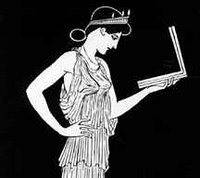Ancient Greek fashion


Greek clothing was very simple and practical. In the winter ancient Greeks wore clothes made of wool, and in the summer they wore clothes made of linen. Clothes and fabric could be bought in the angora, the market place, but it was very expensive. Therefore, many Greeks made their own clothes at home. This was the job of the women: the mother, the daughters, and the female slaves. To be more specific, men wore tunics. A tunic is basically a knee-length t-shirt also made of wool or linen. If it was cold, Greek men wore woolen cloaks or himations over their tunics. Their cloaks could also be used as blankets, for example if they were off fighting a war. As for the shoes, most Greek men didn’t even wear any shoes. And when they did, they were usually basic leather sandals.
Ancient Greek dress was more voluminous than that of the Egyptians, and was most often made of fine woolens, although it is thought that the Greeks also had regular access to linen, hemp cloth and silk. The primary garment of Ancient Greek clothing was the Chiton, an all-over body garment made from a large rectangle of cloth wrapped once around the body from right side to right side.

Around 1.200 B.C. waves of Dorian invaders swept into Greece from Illyria on the east of the Adriatic and brought about the downfall of the Mycenaean civilization. The following four centuries are known as the "Dark Age" of Greece. The period started with a civilization of people dressed in bell-shaped skirts and tightly fitted bodices, and ended with a race dressed in draped clothes, the costumes we now associate with the Greeks and the Romans.
From the seventh century B.C. onwards, we have vast quantities of reference material for the study of costume. Greeks were among the finest exponents of figurative sculpture. Never before had cost
 ume been portrayed with such meticulous care and precision. Statues, together with untold numbers of painted pots, give the historian a unique pictorial history of the development of a nation and its fashions. At the same time, we have the invaluable contribution of the written word. Such great Greek historians as Herodotus have given us very detailed descriptions of developments in fashion and the social significance of costume and their accessories like jewellery
ume been portrayed with such meticulous care and precision. Statues, together with untold numbers of painted pots, give the historian a unique pictorial history of the development of a nation and its fashions. At the same time, we have the invaluable contribution of the written word. Such great Greek historians as Herodotus have given us very detailed descriptions of developments in fashion and the social significance of costume and their accessories like jewelleryThanks to:
costumes
annaswebart
uk.dk.com

0 Comments:
Post a Comment
<< Home